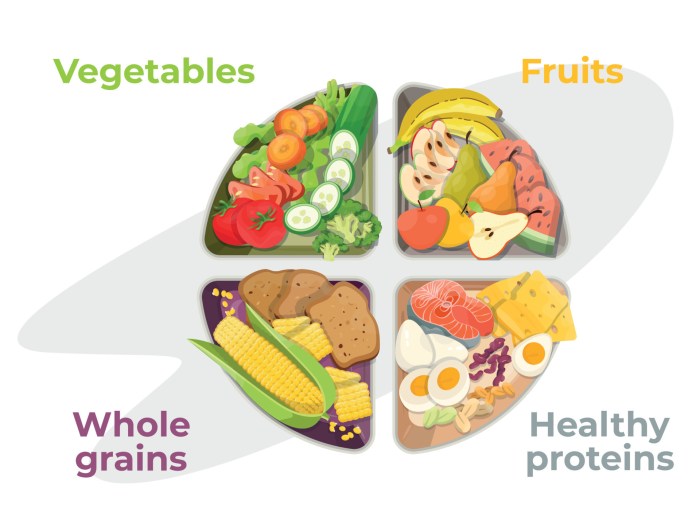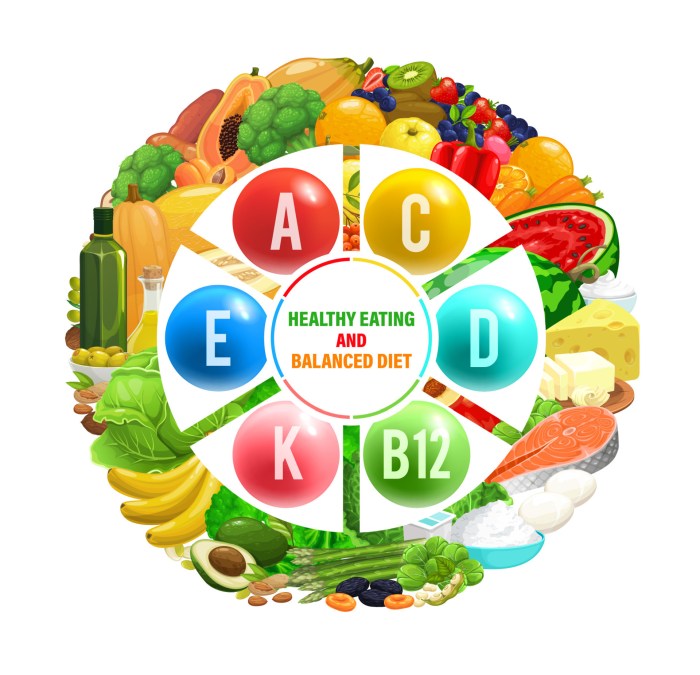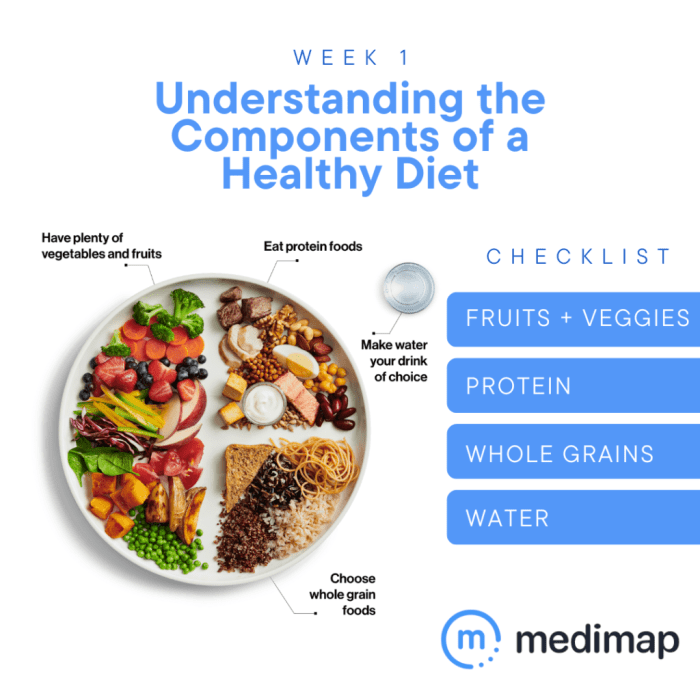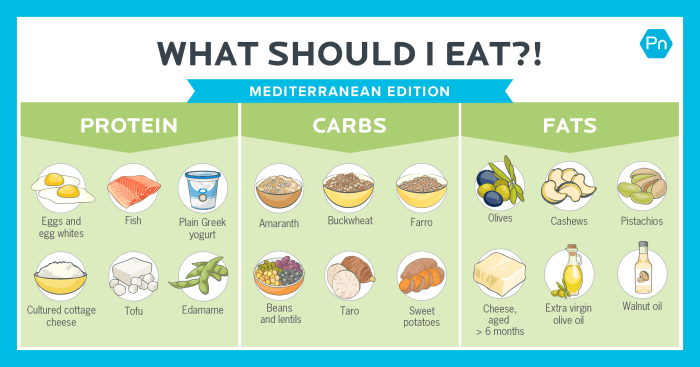Diet A Comprehensive Guide
From ancient civilizations to modern-day wellness trends, the concept of “diet” has profoundly shaped human history and health. This exploration delves into the multifaceted nature of diet, examining its various interpretations – from nutritional plans designed for specific health goals to ingrained eating habits influenced by culture and personal experiences. We will unravel the complexities of different dietary approaches, explore the psychological aspects of food choices, and consider the environmental impact of our eating habits.
We will navigate the landscape of popular diets, analyzing their benefits and drawbacks, while emphasizing the importance of balanced nutrition and sustainable dietary practices. This journey will equip you with the knowledge and tools to make informed choices, fostering a healthier relationship with food and contributing to both personal and planetary well-being.
Defining “Diet”
The term “diet” carries a multifaceted meaning, extending far beyond the connotations of weight loss often associated with it in contemporary culture. It encompasses the sum of food and drink consumed by a person or other organism, encompassing both the nutritional composition and the habitual patterns of eating. Understanding this broad definition is crucial to appreciating its diverse applications and historical context.
The distinction between “diet” as a nutritional plan and “diet” as a habitual eating pattern is fundamental. A nutritional plan, often prescribed by a healthcare professional or dietitian, is a carefully designed regimen aimed at achieving specific health goals, such as managing weight, treating a medical condition, or improving overall well-being. This type of diet is usually temporary, with a defined start and end point. In contrast, a habitual eating pattern represents the long-term, ingrained food choices and behaviors of an individual or population. This habitual diet may be healthy or unhealthy and is often influenced by cultural norms, personal preferences, economic factors, and environmental accessibility.
Diet as a Nutritional Plan
Nutritional plans are structured regimens tailored to meet specific needs. These plans often involve detailed calorie counting, macronutrient ratios (carbohydrates, proteins, fats), and micronutrient intake (vitamins and minerals). For example, a diabetic diet focuses on controlling blood sugar levels through carbohydrate management, while a heart-healthy diet emphasizes reducing saturated and trans fats. The effectiveness of these plans relies heavily on adherence and individual metabolic responses. Variations in plans include low-carbohydrate diets, high-protein diets, and Mediterranean diets, each with its own set of principles and potential benefits and drawbacks.
Diet as a Habitual Eating Pattern
A person’s habitual diet reflects their typical food choices over an extended period. This pattern is shaped by numerous factors. Cultural traditions heavily influence dietary habits. For example, a traditional Japanese diet emphasizes rice, fish, and vegetables, while a typical American diet often includes higher proportions of processed foods, meat, and sugary drinks. Socioeconomic status plays a significant role; access to fresh produce and healthy options is often limited in lower-income communities. Individual preferences and personal beliefs also contribute, leading to variations in food choices even within the same cultural group. Understanding these habitual patterns is critical for public health initiatives aimed at improving overall dietary quality.
Historical Evolution of the Concept of “Diet”
The concept of “diet” has evolved significantly throughout history. In ancient civilizations, dietary practices were largely determined by food availability and cultural traditions. Ancient Greek and Roman texts describe various dietary regimens, often associated with health and well-being, but not necessarily with weight management. The focus shifted in the Middle Ages, with a greater emphasis on medicinal properties of foods. The Renaissance saw the rise of culinary arts and the exploration of new ingredients, influencing dietary practices across Europe. The 20th and 21st centuries witnessed a surge in the scientific understanding of nutrition and the emergence of various dietary trends, often driven by commercial interests and evolving health concerns. This has led to a complex landscape of dietary approaches, with varying levels of scientific evidence supporting their effectiveness.
Types of Diets

Choosing a diet can feel overwhelming given the sheer number of options available. Understanding the characteristics, benefits, and potential drawbacks of various approaches is crucial for making an informed decision that aligns with individual health goals and lifestyle. This section will explore several popular diet types, providing a comparative overview.
Dietary Approaches: A Comparative Overview
| Diet Type | Description | Benefits | Potential Risks |
|---|---|---|---|
| Mediterranean Diet | Emphasizes fruits, vegetables, whole grains, legumes, nuts, seeds, and olive oil; moderate consumption of fish and poultry; limited red meat and processed foods. | Improved heart health, reduced risk of chronic diseases, weight management, increased lifespan. | Can be challenging to maintain, may require careful planning for nutrient adequacy, potential for high sodium intake if not carefully managed. |
| Ketogenic Diet | Very low carbohydrate, high fat diet; forces the body into ketosis, using fat as the primary energy source. | Significant weight loss in the short term, improved blood sugar control in some individuals. | Potential for nutrient deficiencies, increased risk of kidney stones, constipation, “keto flu” (initial side effects), not suitable for everyone (e.g., those with certain medical conditions). |
| Vegan Diet | Excludes all animal products (meat, poultry, fish, dairy, eggs). | Improved heart health, reduced risk of certain cancers, weight management, potential environmental benefits. | Requires careful planning to ensure adequate intake of essential nutrients (vitamin B12, iron, calcium, omega-3 fatty acids), potential for nutrient deficiencies if not properly planned. |
| Paleo Diet | Focuses on foods our ancestors supposedly ate, including lean meats, fish, fruits, vegetables, nuts, and seeds; excludes grains, legumes, dairy, and processed foods. | Weight loss, improved blood sugar control, reduced inflammation (in some individuals). | Potential for nutrient deficiencies, high saturated fat intake if not carefully managed, limited variety of foods. |
| Intermittent Fasting | Cycles between periods of eating and voluntary fasting on a regular schedule (e.g., 16/8 method, 5:2 diet). | Weight loss, improved insulin sensitivity, potential benefits for brain health (some studies suggest this). | May lead to hunger, fatigue, dizziness, difficulty concentrating, not suitable for everyone (e.g., pregnant women, individuals with certain medical conditions). |
Macronutrient Composition Comparison: Three Popular Diets
A bar graph would effectively illustrate the macronutrient composition of three popular diets – Mediterranean, Keto, and Vegan. The horizontal axis would represent the three diet types, while the vertical axis would represent the percentage of macronutrients (carbohydrates, fats, and proteins). Three separate bars for each diet would display the percentage of carbohydrates, fats, and proteins consumed. For instance, the Mediterranean diet bar graph would show a relatively high percentage of carbohydrates, a moderate percentage of fats, and a moderate percentage of protein. The Ketogenic diet would show a very low percentage of carbohydrates, a very high percentage of fats, and a moderate percentage of protein. The Vegan diet would display a varied percentage of carbohydrates and protein, depending on the specific foods consumed, with a lower percentage of fat compared to the other two. The visual comparison would clearly highlight the significant differences in macronutrient ratios across these dietary approaches.
Common Diet Trends and Fads
Many diet trends emerge, promising rapid weight loss or other health benefits. It’s important to approach these with caution, as many lack scientific backing and can even be detrimental to health.
- Detox Diets: Often involve restrictive eating patterns, promising to cleanse the body of toxins. These are generally unnecessary, as the body has its own detoxification systems. Potential drawbacks include nutrient deficiencies and unsustainable weight loss.
- Juice Cleanses: Focus on consuming only juices for a period of time. While offering a temporary boost in fruit and vegetable intake, these are often nutritionally inadequate and can lead to fatigue and nutrient deficiencies.
- Low-Fat Diets: While reducing fat intake can be beneficial, overly restrictive low-fat diets can lead to deficiencies in essential fatty acids and may not always result in sustainable weight loss.
- Specific Food Elimination Diets (without medical necessity): Eliminating entire food groups without medical guidance can lead to nutritional imbalances and deficiencies. This is particularly important for individuals with existing health conditions.
- “Miracle” Diet Pills and Supplements: Many weight-loss supplements are marketed with unsubstantiated claims. It’s crucial to consult a healthcare professional before using any supplements, as some can have adverse effects.
Dietary Guidelines and Recommendations

Establishing healthy eating habits is crucial for overall well-being. Dietary guidelines, developed by organizations like the USDA (United States Department of Agriculture) and the WHO (World Health Organization), provide recommendations for achieving optimal nutrition. These guidelines are based on extensive research and aim to prevent chronic diseases and promote health throughout the lifespan. They emphasize the importance of a balanced diet, regular physical activity, and mindful food choices.
Dietary guidelines generally recommend a balanced intake of macronutrients (carbohydrates, proteins, and fats) and micronutrients (vitamins and minerals). The specific recommended daily allowances (RDAs) vary depending on factors such as age, sex, activity level, and overall health status. However, common themes across various guidelines include emphasizing whole, unprocessed foods and limiting processed foods, sugary drinks, and unhealthy fats.
Recommended Daily Intake of Essential Nutrients
The recommended daily intake of essential nutrients varies greatly depending on age, sex, activity level, and overall health. It’s crucial to consult a healthcare professional or registered dietitian for personalized recommendations. However, general guidelines from organizations like the USDA and WHO emphasize the importance of consuming a variety of nutrient-rich foods from all food groups. These guidelines often provide ranges rather than strict numbers, acknowledging individual needs and variations. For example, the recommended daily allowance for protein might range from 0.8 grams per kilogram of body weight for sedentary adults to a higher amount for athletes. Similarly, vitamin and mineral recommendations vary based on individual needs. Specific values can be found in detailed publications from the USDA and WHO.
Importance of Balanced Nutrition and the Role of Food Groups
A balanced diet encompasses consuming a variety of foods from all food groups in appropriate proportions. This approach ensures the intake of all essential nutrients necessary for optimal bodily functions. The main food groups include fruits, vegetables, whole grains, lean protein sources, and healthy fats. Fruits and vegetables provide essential vitamins, minerals, and fiber, contributing to digestive health and disease prevention. Whole grains offer complex carbohydrates, fiber, and various micronutrients. Lean protein sources, such as fish, poultry, beans, and lentils, are crucial for building and repairing tissues. Healthy fats, found in sources like avocados, nuts, and olive oil, are vital for hormone production and cell function. A balanced diet minimizes the risk of nutrient deficiencies and promotes overall well-being.
Impact of Specific Dietary Deficiencies on Overall Health and Well-being
Inadequate intake of essential nutrients can lead to various health problems. For instance, iron deficiency can cause anemia, characterized by fatigue, weakness, and shortness of breath. Vitamin D deficiency can weaken bones, increasing the risk of fractures. A deficiency in iodine can lead to goiter, an enlargement of the thyroid gland. Furthermore, deficiencies in certain B vitamins can affect nerve function and energy levels. Zinc deficiency can impair immune function and wound healing. These are just a few examples; many other nutrient deficiencies can negatively impact various aspects of health and well-being. Severe deficiencies can lead to serious health complications, highlighting the importance of consuming a balanced and varied diet.
The Psychology of Dieting

The success of any diet plan hinges not just on the nutritional science behind it, but also on the individual’s psychological state and relationship with food. Understanding the psychological factors influencing our eating habits is crucial for achieving sustainable weight management and a healthy lifestyle. These factors are complex and intertwined, impacting our food choices far beyond simple hunger and satiety.
Understanding the interplay between emotions and food intake is key to successful dieting. Our emotional responses significantly shape our dietary choices and habits.
Emotional Eating and its Impact on Weight Management
Emotional eating, characterized by using food to cope with negative emotions like stress, sadness, or boredom, often undermines weight management efforts. Instead of addressing the underlying emotional issue, individuals turn to food for comfort, leading to increased calorie consumption and potential weight gain. This cycle can be difficult to break, as emotional eating provides temporary relief, reinforcing the behavior. For example, a person experiencing workplace stress might find solace in a large bag of chips or a sugary dessert, providing immediate gratification but ultimately contributing to long-term weight problems. The lack of mindful eating further exacerbates this, leading to a disconnect between hunger cues and actual food intake. This can result in overeating even when not physically hungry. Conversely, individuals suppressing emotions may find themselves undereating or engaging in restrictive eating patterns, potentially leading to nutritional deficiencies and other health complications.
Developing a Healthy Relationship with Food
Cultivating a healthy relationship with food involves shifting from a restrictive, diet-focused mindset to a balanced, mindful approach. This requires recognizing and addressing emotional triggers that lead to unhealthy eating habits. Strategies include practicing mindfulness while eating, paying attention to hunger and fullness cues, and identifying and managing underlying emotional issues. Seeking professional help, such as therapy or counseling, can be particularly beneficial in addressing deep-seated emotional patterns.
Strategies for Sustainable Dietary Changes
Sustainable dietary changes are less about strict rules and more about building healthy habits. This includes incorporating regular physical activity, not just for weight loss but also for overall well-being. Focusing on nutrient-dense foods, prioritizing whole, unprocessed options, and limiting processed foods, sugary drinks, and unhealthy fats are essential. Setting realistic, achievable goals, celebrating small victories, and practicing self-compassion are vital for long-term success. Avoid setting extreme goals that are difficult to maintain. For example, instead of drastically cutting out all carbohydrates, gradually reduce intake and replace them with healthier options. It is also crucial to focus on overall health and well-being rather than solely on weight. Prioritizing sleep, stress management, and social connections contributes significantly to successful and sustainable weight management.
Dieting and Health Conditions

Diet plays a crucial role in both the prevention and management of numerous health conditions. Understanding the relationship between specific dietary patterns and disease is vital for promoting overall well-being and improving health outcomes. Tailoring dietary approaches to individual health needs is essential for effective disease management and prevention.
Diet and Diabetes Management
Diabetes, characterized by high blood sugar levels, necessitates careful dietary management. The primary goal is to maintain stable blood glucose levels through controlled carbohydrate intake, balanced macronutrient distribution, and regular meal timing. Individuals with type 1 diabetes require insulin therapy alongside dietary modifications, while those with type 2 diabetes may benefit from weight loss and lifestyle changes, including dietary adjustments, to improve insulin sensitivity. A diet rich in fiber, lean protein, and healthy fats, while limiting processed foods, sugary drinks, and refined carbohydrates, is generally recommended. Portion control is also crucial to prevent blood sugar spikes. For example, a person with diabetes might choose a meal of grilled salmon with steamed vegetables and a small portion of brown rice instead of a sugary cereal with processed meats.
Dietary Approaches to Heart Disease Prevention
Heart disease, encompassing conditions like coronary artery disease and stroke, is significantly influenced by diet. A diet high in saturated and trans fats, cholesterol, and sodium contributes to increased risk. Conversely, a diet rich in fruits, vegetables, whole grains, and lean protein, with an emphasis on healthy fats like those found in olive oil and nuts, is protective. The Mediterranean diet, for example, which emphasizes plant-based foods, olive oil, fish, and moderate amounts of red wine, has been extensively studied and shown to have beneficial effects on cardiovascular health. Reducing sodium intake and maintaining a healthy weight are also crucial components of heart disease prevention. This might involve swapping processed meats for lean poultry and incorporating more leafy greens into daily meals.
Diet and Obesity Management
Obesity, characterized by excessive body fat, is a significant health concern linked to numerous chronic diseases. Effective weight management requires a combination of dietary changes and increased physical activity. A balanced, calorie-controlled diet is fundamental, focusing on nutrient-dense foods and limiting energy-dense, nutrient-poor options. Strategies like mindful eating, portion control, and regular meal timing can be helpful. For example, a person trying to manage obesity might choose smaller portions, focus on whole, unprocessed foods, and incorporate regular exercise into their routine. Restrictive diets may lead to temporary weight loss, but they often prove unsustainable and may even lead to nutrient deficiencies and metabolic imbalances. Sustainable weight management relies on long-term lifestyle modifications.
Risks Associated with Restrictive Diets
While some restrictive diets might initially lead to weight loss, they often carry significant health risks. Nutrient deficiencies are common due to the elimination of entire food groups. These deficiencies can manifest in various ways, including fatigue, weakness, hair loss, and impaired immune function. Furthermore, restrictive diets can lead to disordered eating patterns and potentially contribute to eating disorders. The yo-yo effect, characterized by repeated cycles of weight loss and regain, is also common, potentially increasing the risk of metabolic complications in the long run. For example, a very low-calorie diet may initially lead to rapid weight loss but can result in muscle loss, nutrient deficiencies, and a slowed metabolism, making it harder to maintain weight loss in the long run. Furthermore, such diets can lead to significant psychological distress and a negative relationship with food.
Sustainable Dietary Practices

Adopting a healthy diet shouldn’t feel like a temporary fix; it should be a sustainable lifestyle change. Creating a personalized plan that fits your needs, preferences, and lifestyle is key to long-term success. This involves understanding your own body’s needs, setting realistic goals, and developing strategies to overcome inevitable challenges.
Creating a personalized and sustainable dietary plan requires a thoughtful, step-by-step approach. It’s not about drastic changes, but rather gradual adjustments that lead to lasting improvements in your eating habits.
Creating a Personalized Dietary Plan
Building a successful dietary plan begins with self-assessment. Consider factors such as your current eating habits, dietary preferences, any health conditions, your activity level, and your access to resources like grocery stores and time for meal preparation. Then, set realistic, achievable goals. Instead of aiming for a complete overhaul overnight, focus on small, incremental changes. For example, instead of eliminating all sugar, start by reducing sugary drinks. Gradually increase your intake of fruits and vegetables, aiming for a few extra servings each week. Remember to consult a registered dietitian or healthcare professional for personalized guidance, especially if you have underlying health conditions. They can help you create a plan that aligns with your specific needs and health goals.
Incorporating Mindful Eating Practices
Mindful eating involves paying attention to your body’s hunger and fullness cues, savoring your food, and eating without distractions. This practice helps you develop a healthier relationship with food and promotes better digestion. Start by eating slowly, chewing thoroughly, and putting down your utensils between bites. Avoid eating while watching TV, working, or using your phone. Focus on the taste, texture, and smell of your food. Take time to appreciate your meals and pay attention to your body’s signals of hunger and satiety. Regularly check in with yourself to assess your hunger level before, during, and after meals. Learning to recognize true hunger as opposed to emotional or boredom eating is a crucial element of mindful eating.
Overcoming Challenges in Maintaining a Healthy Diet
Maintaining a healthy diet often presents challenges. Social situations, travel, and busy schedules can make it difficult to stick to your plan. However, proactive strategies can help you navigate these obstacles. Plan ahead for social gatherings by choosing healthy options from the menu or bringing a dish you’ve prepared yourself. Pack healthy snacks and meals when traveling to avoid relying on less nutritious options. Prepare meals in advance to save time during busy weeks. Develop coping mechanisms for stress eating, such as engaging in physical activity, practicing relaxation techniques, or connecting with a support system. Remember that setbacks are normal; the key is to learn from them and get back on track. Don’t let a single slip-up derail your progress. Instead, focus on making consistent, healthy choices most of the time. Keeping a food journal can also be helpful in identifying patterns and triggers that contribute to unhealthy eating habits. This allows for a more targeted approach to address specific challenges and maintain long-term success.
The Impact of Diet on the Environment

Our dietary choices have a profound and often underestimated impact on the environment. From the land used for agriculture to the greenhouse gases emitted during food production and transportation, the food we consume contributes significantly to climate change, biodiversity loss, and water pollution. Understanding this connection is crucial for making informed decisions that promote both personal health and planetary well-being.
Food production methods significantly vary in their environmental footprints. Animal agriculture, for instance, generally carries a much larger environmental burden than plant-based agriculture. This difference stems from various factors, including land use, water consumption, and greenhouse gas emissions.
Environmental Impacts of Different Food Production Methods
The environmental impact of food production varies dramatically depending on the type of food and the methods used to produce it. For example, beef production requires significantly more land and water than the production of plant-based proteins like beans or lentils. Furthermore, livestock farming is a major contributor to greenhouse gas emissions, particularly methane, a potent greenhouse gas with a much higher global warming potential than carbon dioxide. Conversely, plant-based diets generally have a smaller environmental footprint, particularly those that emphasize locally sourced, seasonal produce. Sustainable farming practices, such as crop rotation and reduced pesticide use, can further mitigate the environmental impact of agriculture. Industrialized farming, characterized by intensive use of fertilizers and pesticides, has significant negative consequences for soil health, water quality, and biodiversity.
Carbon Footprint Comparison of Various Diets
Studies consistently show that diets high in animal products, especially red meat, have a significantly larger carbon footprint than plant-based diets. For example, a meta-analysis of several studies found that the average carbon footprint of a meat-heavy diet is several times higher than that of a vegan diet. The carbon footprint of a vegetarian diet falls somewhere in between. These differences are largely due to the higher greenhouse gas emissions associated with animal agriculture, including methane emissions from livestock and nitrous oxide emissions from fertilizer use. Furthermore, the energy required to process and transport animal products also contributes to their higher carbon footprint. A diet rich in locally sourced fruits, vegetables, and legumes will generally have a lower carbon footprint compared to a diet relying heavily on imported foods or processed foods with high packaging.
Strategies for Sustainable Food Choices
Reducing the environmental impact of our diets requires a multifaceted approach. One key strategy is reducing meat consumption, particularly red meat, and incorporating more plant-based protein sources into our diets. Choosing sustainably sourced foods, such as those certified organic or produced using sustainable farming practices, can also help minimize environmental impact. Reducing food waste is another crucial aspect; planning meals, storing food properly, and utilizing leftovers can significantly reduce the environmental footprint of our food consumption. Supporting local farmers markets and choosing seasonal produce reduces transportation emissions and supports local economies. Finally, understanding the environmental impact of different food choices empowers consumers to make more informed and sustainable decisions. Simple changes, like swapping beef for chicken or lentils, can make a collective difference.
Conclusive Thoughts

Understanding diet transcends mere calorie counting; it’s about cultivating a mindful and balanced approach to nourishment. By recognizing the interplay between nutrition, psychology, and environmental sustainability, we can create dietary patterns that support our health, well-being, and the planet. This guide serves as a starting point for your personal exploration, empowering you to make choices that align with your individual needs and values. Remember that consulting a registered dietitian or healthcare professional is crucial for personalized dietary advice, particularly when addressing specific health concerns.
Answers to Common Questions
What is the difference between a fad diet and a sustainable diet?
Fad diets are often restrictive and promise quick weight loss, lacking long-term sustainability. Sustainable diets focus on balanced nutrition, lifestyle changes, and long-term health.
Can I lose weight without completely changing my diet?
Yes, gradual changes like increasing physical activity and making small, healthier food swaps can contribute to weight loss without drastic dietary overhauls.
How can I identify credible sources of dietary information?
Look for information from registered dietitians, reputable health organizations (like the USDA or WHO), and peer-reviewed scientific studies.
What are some strategies for managing emotional eating?
Identify your emotional triggers, practice mindfulness, and find healthy coping mechanisms for stress and negative emotions, such as exercise or meditation.


